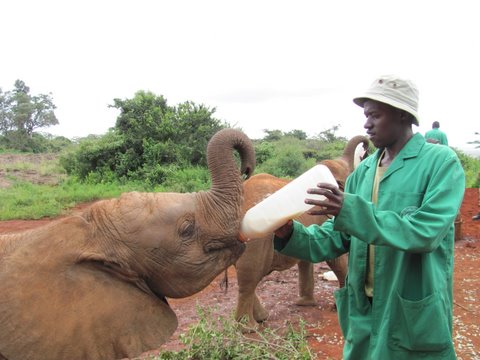Safari in Kenya (With a Stopover in Dubai): Watching the Wildebeest Migration and Searching for Big Cats
"Safari in Kenya (With a Stopover in Dubai): Watching the Wildebeest Migration and Searching for Big Cats, " with photographs by Marcia Jacobson, The Syracuse Post-Standard Sunday STARS Magazine, Oct. 10, 2010, 13-15.
Imagine yourself in a Safari Camp in Northern Kenya having breakfast at your own table looking over the Ewao Nyiro. A flutist from the Samburu tribe in native dress serenades you when he is not scaring away monkeys, sometimes with a slingshot. Later that afternoon, you go on a game drive and see elephants, giraffes, perhaps a lion with cubs.
Or: Imagine you are in a Safari Camp in Masai Mari and hippos are swimming fifteen feet below your private tent deck. You sit in the outdoor bathtub set on the deck and watching the hippos.
Or perhaps in Masai Mara you come upon three young male cheetahs frolicking in the grass. No other safari vehicles are around and you watch them for thirty minutes before your driver radios his colleagues; you are moved to tears by the cheetahs' elegant beauty.
Or in Masai Mara, your safari driver comes upon a small pride of lions. You see ten, some adult females, some cubs (one with blood on its face from a recent meal)—and watch the playful cubs nudge one another and resist parental leadership.
Our Odyssey begins:
Because there are no direct flights from New York to Kenya, my wife, Marcia Jacobson, and I, decided to do a stopover on the way so we could arrive in Kenya rested for the adventure to follow. I had wanted to try the well-regarded Emirate Airlines so, I thought why not a stopover in Dubai? One of the seven Emirates that constitute The United Arab Emirates, Dubai in recent years has become a focal point in the Mid-East because of its rapid development financed by oil money, much of it from its another of the Emirates, Abu Dhabi.
We began our June journey with an uneventful 12 hour plus flight on Emirate Airlines. Once an elite airline even in economy class, now its food and legroom in economy class is pedestrian and no better than average, but the enthusiastic flight attendants provide excellent service. Dubai is based on the somewhat tenuous premise that a significant percentage of the world's ultra rich will want to reside some parts of the year in the desert. Developers seem to have had exaggerated ideas of Dubai's ability to attract the world's mega rich. Dubai is now suffering from overbuilding as well as the fallout from the world recession. Building projects have been abandoned, often in the middle of construction, and plans—now on hold-- for elaborate growth seem based on fantasy expectations. Houses, apartments, and office space are unsold or unrented.
In summer, when we were there, it is excruciatingly hot with temperatures reaching 120 Fahrenheit and more. You need to drink plenty of water and spend most of the time in air-conditioned space.
Recommended (but certainly not a necessity) in Dubai is what is called a " sundown Safari" excursion. From 4:30 pm to 9:30 pm (including round trip to and from the hotel), the evening consists of a desert drive in four-wheel vehicles climaxing in a splendid sunset view, a brief camel ride, a mediocre Middle Eastern buffet dinner, a belly dancer (who happened to be Russian) and the possibility--which I declined--of smoking a Turkish/Arabic water pipe. On our night about 150 people signed up for this touristy activity costing in the neighborhood of $100 each. Given that our focus this trip was on animal sightseeing, a highlight was seeing a white oryx with black legs and black horns; we also saw gazelles in the desert.
On our five hour private city tour, we saw the old city—featuring a fine history museum and the souks specializing, respectively, in gold and spices--and the new city which features man-made islands with fancy hotels (the Atlantis has a wonderful aquarium) and posh residences. We had dinner overlooking the spectacular fountains of the Dubai Tower, the world's tallest building.
After two days in Dubai—you can see most of the essentials in that time--we flew to Kenya, a flight of a little less than five hours.
Kenya
A country of about 40 million residents, Kenya is under a US State Department travel advisory (http://travel.state.gov/travel/cis_pa_tw/tw/tw_923.html) and has been the site of scattered terrorism, including major attacks on the US Embassy in 1998 and on a Mombasa hotel in 2002, as well as periodic political ructions. While we were in Nairobi someone threw at a rally of those opposed to the upcoming Constitutional referendum on Aug 4, 2010.
Nairobi, Kenya's capital and largest city, is an important East African city of over 4 million residents with comfortable residential areas as well as major slums; Kibera is the second largest slum in Africa. Nairobi has horrendous traffic jams that recall those in Mumbai or Bangkok and that makes sightseeing difficult. Cars are not air-conditioned and one can sit sweltering in traffic.
Lodging in Nairobi
We decided on boutique lodges and camps rather than international hotels; these include three meals a day and, within safari areas, game drives with experienced driver-guides. Some of the lodges and camps include all drinks (a very small item for us) and laundry.
After arriving for our first night in Nairobi at Giraffe Manor—a small inn in the well-to-do Karen district (named after Karen Blixen aka Isak Dinesen of Out of Africa fame), we watched majestic Rothschild Giraffes from the adjacent Giraffe sanctuary come into the yard. They took small pellets right out of our hands with long bluish tongues. Meanwhile, warthogs wandered about the environs; to top off our first hours in Kenya, an eagle lurked nearby. We awoke to giraffes peaking into our second story bedroom windows and we fed them again.
|
In the morning of our second day, we went to the Sheldrick Elephant Rescue Center, which is open only from 11-12 and watched a presentation complete with baby elephants about how the Center rescues and restores to their wild environment elephants whose mothers die or have been killed.
Our second Nairobi night was spent at Ngong House, named after the nearby Ngong Hills. Each guest couple or family has their own tree house. Our fish lunch was one of the best meals we had, but beef and lamb for dinner were mediocre. I was not convinced that the host owner was as fully engaged in his hospitality as the hosts of Giraffe Manor, who were in fact standing in for the absent hosts. Little details were missing; we had to wander in the dark to find both our dwelling and the dining area. For our afternoon Nairobi city tour, Ngong house was supposed to provide an accomplished guide and driver; instead we had a confused rookie who did not know the sites or how to drive in Nairobi.
The Nairobi National Museum with its fine display on the evolution of man—in a section entitled "Cradle of Humankind"--should not be missed, notwithstanding the traffic. Also, the National Museum's display of tribal cultures helped us better understand the natives of Samburu and Masai Mara.
Safari Stops
Game sighting is a wonderfully exciting activity in Jeeps, Land Rovers, or Land Cruisers; they are driven by safari guides and sometimes accompanied by a spotter who helps the driver locate game. Often but not always, our vehicles had open roofs so that travelers can stand for sightings and photography. We had done some game sighting as part of a prior Africa trip that also took us to South Africa, Zimbabwe, Botswana, and Swaziland, but that was about 6 days out of 18 or so.
|
After our two nights in Nairobi, we flew to Samburu in Northern Kenya and, while we didn't see everything, we enjoyed those two days immensely. The first days of a safari are when you are excited about every sighting; later the focus may be on particular animals, especially the elusive "big cats," namely lions, cheetahs, and leopards.
Located a little outside Samburu National Reserve, Sasaab, our first and in some ways our most elegant camp, caters to an upscale market. Each guest or couple gets their own tent house with (cold) plunge pool. Here as elsewhere canvas tents are on a concrete slab, and each tent has its own private bathroom and shower. Because of flooding that washed out the direct route from the landing strip to our lodge, we had a hundred mile drive form the landing strip in Buffalo Springs Reserve over roads that might better be called ruts. But we took advantage of that by going through two major game preserves—Buffalo Springs and Samburu—on a drive that lasted more than six hours. On this drive we saw five lions—two females and three cubs—a cheetah, baboons, elephants, cape buffalo, dik-diks (tiny antelopes) plus five species unique to this region—the Samburu Five: Gerenuk (long-necked or "giraffe" gazelle), Beisa Oryx, Reticulated giraffe, blue necked Somali ostrich, and Grevy's Zebra. We also had some spectacular bird sightings, including the Giant Eagle Owl, the world's largest owl.
Our second Samburu day we took a morning, afternoon, and evening Safari drive in addition to a game walk. We spent that night at Larsons, another upscale camp but this one within Samburu Reserve. With a different driver, we saw the same lion group as we saw the first day. We just missed a leopard sighting that other passengers in other vehicles saw. We also saw kudus that day. On the next day, our 3-hour drive back through the Samburu Reserve through the small town of Archers Point and back to the Buffalo Springs airstrip was another occasion for a game drive.
After flying back to Nairobi and driving two and half hours northwest to Nakuru, we stayed overnight with Karin and David Sugden, owners of the Kenya group that put together our Safari. The next day we spent four hours at Lake Nakuru National Park. There we saw where we saw white and black rhinos—at one point a female white rhino and male black rhino within a few yards of one another—and the famous flamingoes, a natural blanket of pink on the Lake--and an eland, herds of both cape buffalo and zebras, and giraffes, as well as many unusual birds.
We spent that night at the Great Rift Valley Lodge where we encountered a well-meaning but puzzled and marginally competent staff and a mediocre buffet that wasn't close to the standards of our other lodges and camps. But the property offers stunning views of the Rift Valley, nicely tended grounds, and an informed guide available for a bird walk. Since this is really a conference hotel, we didn't at first receive the kind of attention we expected. When we complained, we experienced a far different hotel staff and were given a "bush breakfast" with champagne and a fine lunch with an Indian inflection.
Our last Safari stop was at the legendary Masai Mara, the heart of the Kenya Safari experience. We spent one night at Intrepids tented and the next night at Explorer, its sister tented camp; both are own by Heritage Hotels. Intrepids is the more modest and less exclusive camp and has more than three times as many tent lodgings. (What defines the more exclusive lodges is the level of service and the smaller number of tents). At Intrepids we were at the very end of a long row of tents and did not have much of a view. On the other hand, we enjoyed the local dancers who put on a show at dinner. At the Explorer, we overlooked the hippos on the Talek River, a tributary of the Mara. Both camps turned off the electricity for some hours and the Intrepids limited the hot water flow to certain hours, although they were amenable to extending the bathing hours.
A breathtakingly exhilarating experience was a sunrise hot air balloon ride over the Masai Marai savannah. Lasting about 75 minutes with twelve passengers to a balloon and followed by a "bush breakfast" and some game driving back from balloon site, it is an expensive but highly recommended indulgence. We saw beginning of wildebeest (a large antelope) and zebra migration; over one million wildebeests and 300,000 zebras cross the Mara River to make their way to Tanzania in search of better pastures before returning later in the year.
Tented Safari Camps
The service at these camps is exceptional; a large staff from nearby villages takes care of a relatively small number of guests with genuinely gracious hospitality. Yes, there are remnants of obsequious colonialism. Much of the staff is paid a pittance and a large black population waits on a handful of wealthy travelers.
In most of the Safari camps electricity is off for as much as 12 hours a day in the name of sustainability but I suspect in some cases to save money. Hot water times may also be limited. Camp food is not to be confused with high quality urban restaurants, although some of the camps pretend that it is. Fresh fruits are wonderful and served with every meal. Some soups and desserts were quite good. Some of the main courses, both slightly pretentious and posing as gourmet food as well as more simple dishes like fried fish varied from quite decent to, in one case of a fish dinner at Larsons, quite awful. Meat and lamb varied, but except for one steak at Intrepids, was quite pedestrian. The only place with fresh juice was Sasaab. Every once in a while I found a pleasant surprise, as when I discovered "pancakes," meant delicious light crepes. Most breads were disappointing, and what posed at breakfast for croissants and Danish were mediocre minus.
Kenya Essentials:
You need a visa which can be purchased before you leave or at the airport. Be aware that in Kenya one needs to take Malaria pills, although they are not necessary in Nairobi, the capital city.
Be aware that you are outside your safety net; no defibrillators and not much western medicine in the bush, although our Kenya Company enrolled us in Flying Doctors, a service that will pick you up and take you to Nairobi if you are ill. Some lodges do have access to a health worker, but these are usually not medical doctors.
Expect to be bouncing around on unpaved roads in safari vehicles and expect that the quality of the rest of the roads, even in upscale suburbs, often means more bouncing. While there are some highways, many roads are terrible, some of the worst I have ever seen—at times really no more than unleveled dirt patches with rocks in the middle punctuated by huge potholes--and drivers are aggressive. I recommend flying when possible, although know that you will not only be flying around Kenya in small props—sometimes without a co-pilot-- but landing on small air strips in the bush. We did our internal air traveling on Safarilink; some travelers pay extra for charters.
If possible, stay in a camp for two nights; we spent too much time moving about and it prevented us from having as much exercise and reading time as we like.
Conclusion:
Surely, this was one of our most satisfying trips. After our first two days in Nairobi, the Kenya trip was mostly about game sighting, although visits to the Masai and Samburu villages and/or conversations with guides and hotel employees are instructive about tribal life. Kenya is more adventure than relaxing vacation, and unless you do a much slower paced trip than ours or cut back drastically on the several hours per day game sighting, you will not have leisure time for exercise or reading.
If You Go:
For Round trip flights from New York, plan on about $1450 for economy class.
Our Kenya trip was organized by Karin Jones of Anastasia Travel with Africa House Safaris in Kenya, a company owned by Karin and Davey Sugden. (Full disclosure: the Sugdens hosted us for a splendid dinner, breakfast, and overnight at their home in Nakuru.)
Intercontinental Hotel, Dubai—quite splendid and not too expensive in summer; we had a well-appointed modern room and access to the hotel's Clubroom.


 Kenya, elephant orphanage in Nairobi
Kenya, elephant orphanage in Nairobi Kenya, cheeta in the Mdasa Mara
Kenya, cheeta in the Mdasa Mara